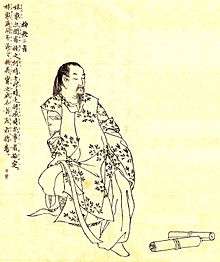Fujiwara no Matate
| Fujiwara no Matate 藤原真楯 | |
|---|---|
 Illustration by Kikuchi Yōsai, from "Zenken-Kojitsu" (pub. 1903) | |
| Family | Fujiwara Hokke |
| Father | Fujiwara no Fusasaki |
| Born | 715 |
| Died | April 25, 766 |
Fujiwara no Matate (藤原真楯, 715 – April 25, 766) was a Japanese noble of the Nara period. He was the third son of the founder of the Hokke branch of the Fujiwara, the sangi Fujiwara no Fusasaki. He achieved the court rank of shō san-mi (正三位) and the position of dainagon, and posthumously of daijō-daijin. His original name was Yatsuka (八束).
Life
Emperor Shōmu recognized Yatsuka's abilities, and through his favor Yatsuka was rapidly promoted. He was raised in the year 740 from the rank of shō roku-i no jō (正六位上) to ju go-i no ge (従五位下) and then ju go-i no jō (従五位上), in 743 to shō go-i no jō (正五位上), and in 744 to ju shi-i no ge (従四位下). Shōmu specially entrusted him with duties related to the transmission of reports to and requests from the emperor. According to the Shoku Nihongi, Yatsuka was respected as exceptionally intelligent, incurring the jealousy of his cousin Fujiwara no Nakamaro. He is then said to have secluded himself in his home for a time, with his books for company. In 748 he was promoted to sangi, beating his one-year-older brother Nagate to the ranks of the kugyō.
In 756, shortly after the death of Emperor Shōmu, Nagate was promoted directly to chūnagon, overtaking Yatsuka. In 758, he supported Nakamaro's renaming of various government offices in the Chinese style of the Tang dynasty, and in 760 Yatsuka himself was granted the Tang-style name of Matate. He was steadily promoted to ju san-mi (従三位) in 760 and to chūnagon in 762. Also in this period, he held a farewell feast for Yōshōkei (揚承慶) of the fourth envoy expedition from Balhae to the court, which the latter greatly appreciated.
In Nakamaro's rebellion of 764, Matate supported the winning side of Empress Kōken, and was promoted to shō san-mi (正三位) and jutō-taishō and granted honors, second-class. In 766, Matate was promoted to dainagon, replacing Nagate, who had been promoted to udaijin. Two months later, though, Matate died at the age of 52. He was given the burial of a daijin (大臣), and posthumously promoted to daijō-daijin.
In Matate's day, the ruling power was Nakamaro, putting the Nanke in the predominant position. Moreover, Matate's older brother and head of house Nagate held a position at the daijin level. In the late Nara period, an equality between the clans was considered ideal, and for important positions to be held by father–son or sibling pairs still incurred criticism. For Matate too to be promoted as far as dainagon implies that this due in large part to his own ability. In later years, Matate's descendants included Fujiwara no Michinaga and Fujiwara no Yorimichi, who led the Fujiwara to the peak of their power.
Matate was a magnanimous man, with a talent for assisting emperors in their governance as a politician. Eight of his works are recorded in the Man'yōshū, including seven tanka and one sedoka. Notes in the same work suggest Matate had a personal friendship with Ōtomo no Yakamochi.
Genealogy
- Father: Fujiwara no Fusasaki
- Mother: Muro no Ōkimi (daughter of Prince Minu)
- Wife: (daughter of Sami no Natemaro (佐味奈氐麻呂))
- Son: Fujiwara no Managa (藤原真永)
- Son: Fujiwara no Nagatsugu (藤原永継)
- Wife: (daughter of Abe no Obimaro)
- Son: Fujiwara no Uchimaro (756–812)
References
- Nomura, Tadao (1970). "永手・真楯(八束)・御楯(千尋)" [Nagate, Matate, and Mitate]. Shishū (史聚) (in Japanese) (12).
- Maeda, Haruto (1996–1997). "藤原八束(真楯)の改名問題" [The Problem of Fujiwara no Yatsuka (Matate)'s Renaming]. Ancient Cultures of East Asia (東アジアの古代文化) (in Japanese) (89–91).
- Yoshikawa, Toshiko (2006). "仲麻呂政権と藤原永手・八束(真楯)・千尋(御楯)" [Nakamaro's Administration and Fujiwara no Nagate, Matate, and Mitate]. 律令貴族成立史の研究 [Research on the Establishment of the Ritsuryō Nobles] (in Japanese). Hanawa Shobō (塙書房). ISBN 978-4-8273-1201-0.
- Kimoto, Yoshinobu (2005). "藤原真楯薨伝について" [On Fujiwara no Matate's Obituary]. Ancient Culture (古代文化) (in Japanese). 57 (3).
- Kimoto, Yoshinobu (2007). "『続日本紀』藤原真楯薨伝・再論" [Revisiting Fujiwara no Matate's Obituary in the Shoku Nihongi]. Politico-Economic History (政治経済史学) (in Japanese) (491).